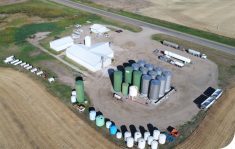OMAHA, Neb. – They are big, fast and yellow.
Claas of America recently unveiled its new series of class 6 to 9 combines – the Lexicon 770.
Big is manifested in several ways in the new designs.
The 770, the largest in the new 700 series, has 523 horsepower, one of the industry’s biggest grain tanks at 360 bushels, a more spacious cab and aggressive chaff and straw management options.
Fast enters the picture with the machine’s track system, which allows it to travel up to 40 km/h on the road.
Read Also

Volunteers help exotic animal farm rebuild
Exotic animal farm loses beloved camel and pony to huge hail storm that gripped the Brooks, Alta. area as a community member starts a fundraiser to help the family recover from the financial and emotional damage.
Wheeled options are also available, but Bob Armstrong, Claas’ product marketing manager, thinks speed on tracks will be a major selling point for Canadian farmers.
“I think they are really going to like the track system,” he said. “It’s our generation three of tracks and a lot of our market is understanding that it’s not just for mud and those conditions. It adds a lot of stability and a much smoother ride than any wheeled machine.”
Product manager Scott Wellensiek said limited speed on tracks may once have affected their popularity in Canada, where distances between fields can be a limiting factor in the short harvest window.
“Ground compaction and stability are always concerns for every farmer,” Wellensiek said.
“Optimizing flotation with the new Terra Trac system, where we’re integrating the suspension within the track belt, gives the operator more comfort.”
Along with its series launch, Claas introduced new draper and Vario headers, some of them designed with western Canadian needs in mind.
“The new Maxflo header that we’re offering is really a revolution in draper technology, so that’s a prime fit for the western Canadian producer,” Wellensiek said.
“On the traditional draper, you’ve got a centre belt conveying the material from the side belts into the machine. With the Maxflo system, that’s been removed because there’s no adapter within the header, bringing the cutter bar closer to the cab.
“Also, we’re taking our centre feed drum and bringing that closer to the cutter bar. The material coming off the side belts goes directly underneath the feed belt, the feed drum, right at the feeder house. Bottom line, we’re eliminating some of the complexity.”
The Vario headers, with cutting knives that can be moved forward or back, can serve well in the varied crops grown on the Prairies. The design is popular with European rapeseed producers managing heavy and variable maturity crops.
“It’s a very good small grains header that can be used in different types of crops,” he said. “If you also have canola in your rotation, you can extend it all the way out, put the vertical side knives on, and straight cut canola.”
Further into the threshing process, the new Lexions use a hybrid system that combines accelerated pre-separation (APS) with dual rotors. Promotional material says up to 30 percent of all grain is pre-separated through the APS cylinder concave, reducing the load on the main concave.
A new cab design is another selling point, according to Beaverlodge, Alta., dealer Jesse Foster of Foster’s Agri-World, who was in Omaha for a preview in early August.
“The cab was too small and not fancy enough, so they’ve added a lot of nice features,” Foster said.
Among them are improved visibility and soundproofing, a full-sized trainer seat, a multi-function handle for the most often used controls and an electronic information system.
The latter encompasses yield and moisture monitoring, acre counter, yield mapping and steering options including laser, auto and cruise pilot.
“Cruise pilot is a system that automatically controls the forward travel speed of the Lexion, so by activating the autopilot valve of the multifunction handle, it monitors the amount of material…. You can set it to monitor the losses, so it’s not going to push the machine too fast,” Wellensiek said.
“That’s probably one of the fortes of the Lexion, is the ability to retain the grain and then the very accurate loss sensors on the sieve and the rotor.”
The cab is also equipped with an enhanced lighting package for working at night.
Foster thinks the chopper options will also be popular with his prairie customers.
“We’ve had customers ask for it.”
Those options include the turbo chop and the pro chop.
The turbo model has 88 dual blade knives spinning at up to 3,450 r.p.m. and a bank of 62 stationary blades.
The pro chop has 108 dual-bladed knives working with the 62 stationary blades. Both are capable of distributing straw and chaff up to the width of the header, as much as 45 feet.
“The pro chop is one step higher, with the number of knives at 108, and it also has comfort features like in-cab spread width adjustment,” he said.
“You can dial it down, or let’s say there’s a side wind. You can compensate for that by turning it to blow the material into the wind.”
There are five machines in the 700 series, from Class 6 to Class 9, although Claas refers to the 770 as a Class 10 model.
For more information: www.claasamerica.com

















